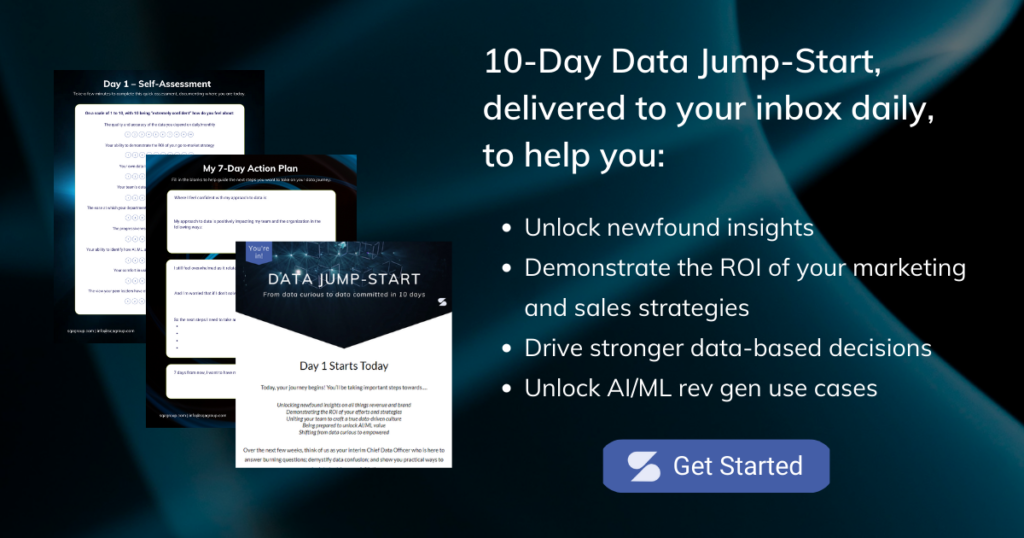This time of year always raises a swirl of emotions for us revenue leaders. All eyes shift to…
Galvanizing sales teams to crush Q4 quotas while creating strong pipeline for the year ahead
Delivering unbelievable client VIP experiences — don’t forget the holiday cards!
Navigating the conference and trade show circuit
Crafting scaling and growth strategies for the year ahead
Post-mortem-ing everything… what worked, where did we stumble, and what would we do differently next time?
And in recent years, one more important to-do has topped our Q4 list — particularly if we lead Sales, Marketing, Growth, or Revenue.
Review analyst tech predictions to incorporate emerging technologies and innovation frameworks as core underpinnings to fuel your growth strategy.
Gone are the days when we could wait for IT or our Tech peer leaders to suggest we take advantage of some of the newest trends (cloud, IoT, digital transformation, etc.). Today, it is just as much OUR responsibility to be diving into and combing through these reports to understand the role we play in bringing the latest tech trends — artificial intelligence, machine learning, automation, digitization — into our departments.
Related Reading: Do You Have an AI Strategy?
So what do we need to prepare for as 2023 approaches as it relates to tech? Let’s explore a big one…
Data-Driven Decision Making
Recently, Gartner put forth its Top 10 Strategic Technology Trends for 2023 which includes, among other things, a focus on investing in digital immunity, integrating artificial intelligence practices, and uncovering performance metrics that prove a company’s sustainability commitment.
The one technology trend prediction that rev leaders shouldn’t ignore?
Applied Observability.
As Gartner states…
“Applied observability is the applied use of observable data in a highly orchestrated and integrated approach across business functions, applications and infrastructure and operations (I&O) teams to enable the shortest latency from action to reaction and proactive planning of business decisions.
Applied observability allows enterprises to make faster, more accurate future decisions. By applying this systematically, we can reduce the latency for response and optimize business operations in real-time.”
As rev leaders, we’re sitting on a sea of data that we collect regularly on our prospects, clients, partners, shareholders, etc. Raw data is everywhere — customer feedback responses, raw revenue, prospect job titles, zip codes, etc.— and the places it’s collected are far-reaching. CRMs. Email marketing tools. The website. Customer surveys. Customer service portals.
The imperative then is to quickly move from raw data collection to context and analytics, which gets into how we make sense of the raw data and uncover trends, patterns, and correlations — e.g. determining effective GTM channels, uncovering YoY/MoM omni-channel performance trends, identifying product launch possibilities, CAC, CLV, etc. More on that here.
Applied observability, as Gartner describes, allows us to shift from raw data → context → analytics → data-driven decisions.
Imagine if you allocated energy to converting even 10% of your raw data into analytics that could be assessed to improve the efficacy of your go-to-market strategy. Think of how it might change…
- Who your ICP actually is
- The way you approach content creation to convert vs. delight
- Omni-channel spend allocation (Call blitz days or golf outings? Which is actually more effective?)
- Team re-orgs to aim your team against that which moves the needle most
- Who the look-a-like clients truly are
- Marketing ad and PR budgets
The WHY Matters
Here’s a quick example of WHY converting our raw data into analytics is so important, especially as the revenue drivers for our businesses.
Research shows that marketers waste approximately 26% of their budgets on unproductive strategies and ineffectual channels. A huge culprit of the waste? Not taking time to analyze the raw data that is being collected daily for the strategies.
On a $1 million budget that’s a whopping $260,000 wasted.
With a quarter of a million dollars invested RIGHT (not gambled away) you could:
- Invest in 20+ AI technologies — chatbots, automated copy writing, intelligent proofreading, customer review management, autogenerated PRs
- Hire 2-3 new people for your team
- Hold 50+ VIP client dinners a year
- Outsource almost all your digital marketing needs
That’s one of many reasons WHY this all matters.
It matters to be a data-driven revenue leader. To be current on the analyst predictions and how they impact your ability to drive success within your department. And it matters when it comes to incorporating the tech trends. We can’t wait for IT because rev leaders at other firms are already doing so.
So what if you choose today to move the needle and consider how you can adopt applied observability? Can you pick one part of your go-to-market strategy in which you spend more time collecting data versus analyzing it? Can you commit to shifting from raw to context to analytics in the next 4 weeks? Think of the formula above as a reminder of WHY this matters.
You could be sitting on a major decision you need to make for next year as it relates to re-aim and new direction setting for you team.
Want more tips on how to incorporate rev-fueled, data-driven strategy? Click here to sign up for our complimentary 10-Day Data Jump Start, designed specifically for rev leaders, providing you with the data concepts you need to bring your team into the next era of rev gen.


